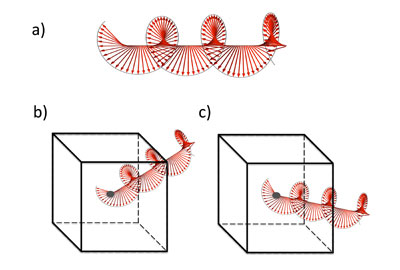| Mar 12, 2012 |
Quantum order-by-disorder and the mystery of the partially ordered phase of MnSi
|
|
(Nanowerk News) We often think of random forces as destabilizing a system from its equilibrium. For example, turbulence on an aeroplane can cause us to spill our coffee. However, there are many cases where random forces, fluctuations or noise as they are commonly known to physicists, can stabilize a system in a state that would not be stable in the absence of noise. Examples of this occur in mechanics, for example a multiple-jointed pendulum can be stabilised in an inverted configuration if it is driven with random forces at its support, or, in population dynamics where certain populations may be stabilised because of the intrinsic noisiness of the environment.
|
|
Fluctuations due to the intrinsic uncertainty of quantum mechanics can have a similar effect and Professor Andrew G. Green, from the London Centre for Nanotechnology, has developed a new way to apply these ideas to metallic magnets (see paper in Physical Review Letters: "Quantum Order-by-Disorder Near Criticality and the Secret of Partial Order in MnSi").
|
 |
| a) In MnSi, the magnetic order adopts a spiral configuration as shown. b) When quantum fluctuations are small, the spirals are oriented in directions pointing towards the corners of the cubic crystal lattice. c) When the quantum fluctuations are large, the spirals fluctuate about a new direction pointing towards the edges of the cubic crystal lattice.
|
|
At certain points in the phase diagram of a magnet, determined by values of pressure, magnetic field etc., quantum fluctuations can become dramatically enhanced. These enhanced fluctuations can stabilise new phases in just the way that the classical fluctuations described above. The best place to find such enhanced quantum fluctuations is near to quantum critical points; points at zero temperature where changing the system parameters at zero-temperature leads to a phase transition between different types of behaviour.
|
|
The material MnSi adopts a curious type of ferromagnetic order where the orientation of the ferromagnet spirals in space. Professor Green has shown how near to a quantum critical point in this material, quantum fluctuations can cause the orientation of the spirals to change - rather than pointing towards the corners of the cubic lattice, the spirals fluctuate about a direction pointing towards the edges. This is very similar to the classical example of the pendulum adopting an inverted configuration when its support is driven by noise.
|
|
The quantum order by disorder approach to this provides a conceptually simple way to accommodate these effects. The hope is that this simplified understanding will ultimately help us to harness and control such effects of quantum fluctuations to produce material with properties of technological benefit.
|
|
|

